
The start of our large autumn harvest
Death by mushroom happens every year, as it has for hundreds of years, but it does not deter me from gathering my favorite edible fungus, Grifola frondosa, sometimes called hen of the woods. Death in mushroom is a newer concept, and one I first heard of at a recent mushroom party. As a gatherer and eater of wild mushrooms, and someone who loves wandering old cemeteries but never wants to be in one, being buried in a mushroom shroud has a purity and simplicity that appeals.
It is mid October, leaf peeper season, and the leaves of the trees are burnt orange with an occasional blast of bright red. Storms have not yet stripped the branches, and photographers gather at choice locations to capture the glory of the Maine autumn. It has been a spectacular and long-lasting fall. This is also maitake season. My husband has joined me foraging, and our first outing yielded a half dozen rosettes of these earthy and flavorful mushrooms. More than once we filled the trunk of the car, and gladly gave them to fellow mushroom lovers. This fall we harvested about a hundred pounds. Other gatherers are collecting massive amounts as well. An abundance of color has coincided with an abundance of maitake several times. Years with few mushrooms have been paired with less than glorious foliage. Coincidence, or do the same weather conditions and temperatures that stimulate vibrant fall leaf colors also promote maitake growth? If there is a scientific connection I would like to know, but not knowing doesn’t dampen my mushroom fever at seeing so many giant fungi, and I cannot stop gathering them.
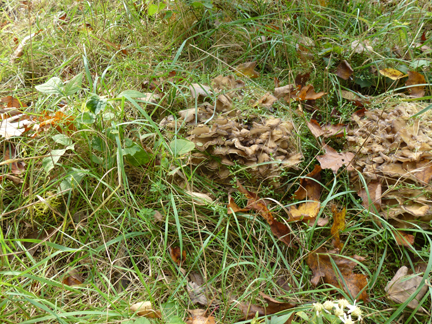
In late September we drove along a dirt road though an old forest. ”Stop,’” I called. It was the first spotting of the season. Three large clumps of maitake rose above the ground cover of damp oak leaves, but they were blackened and gelatinous. They would grace no one’s table. Maitake have a firm slightly toothy texture when cooked, and retain their shape and size, not diminishing the way commercial white mushrooms do. Their flavor is deep and full, earthy and buttery. We have found them in other months, but it is late September and early October when we hunt them seriously. Fall is also prime time for many other mushrooms in Maine—hedgehogs, black trumpets, or a second fruiting of chanterelles. It is also the season for Laeitoporus sulphureus, or chicken of the woods, and we have harvested a good year’s supply from the stump of a two hundred year old ash tree just cut down at my husband’s family camp. These bright orange mushrooms are meaty, do not have much water content and when cooked are very like chicken in texture. Delicious, but it is maitake that capture my soul.
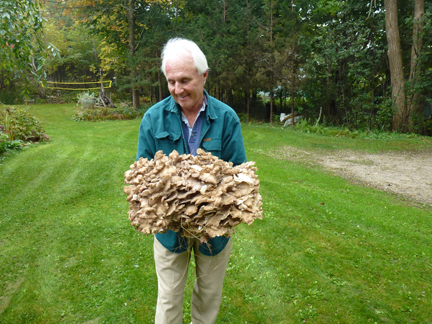
There are a few locations we check annually, and some produce year after year. Harvests vary widely, though. Last year we had perhaps five pounds, all were eaten or shared, and none saved for the winter. Next year may be equally slim. And so it was that this year’s bounty was greedily collected. We ate maitake in omelets and we added it to soup and stews. We sautéed it with bacon and added cream and rosemary for a pasta sauce. We had maitake and Swiss cheese quesadillas. My husband went off on a fishing trip, and I looked at the close to hundred pounds of fresh maitake on the table in the backyard. It was the first time I ever gazed at these delicious monsters with dismay. They might still be fine in a few days when he returned to help process them, but they might not, and to pick them and not use them was not an option.
A few phone calls and the mushroom party was on. The model is as old as community. I had mushrooms, and I needed help. The friends who came took away half of what they bagged, we had plenty for our winter supply, and in a few hours the table buried in mushrooms was bare. It is a simple formula to share a harvest, and share an evening. We covered the dining room table in paper and everyone took a pile of mushroom, a soft brush to clean off dirt, and a knife to cut away any spongy or questionable areas. Wine was poured; local feta, seedy crackers, and red pepper quiche were consumed.
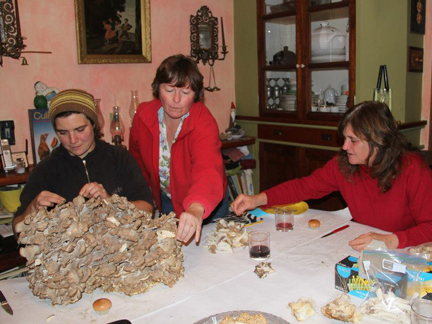
This was a hen gathering, quite appropriate for hen of the woods. There is freedom in a gathering of all women, laughter flows and hands never stop working. We exchanged information. “Where does one find all these mushrooms?” Tammy asked. While it was indeed a shame I had to pretend I had forgotten exactly where we found them, I could at least offer advice–they are most commonly found at the base of older oaks, usually trees with signs of damage such as a dead limb or lightening strike.
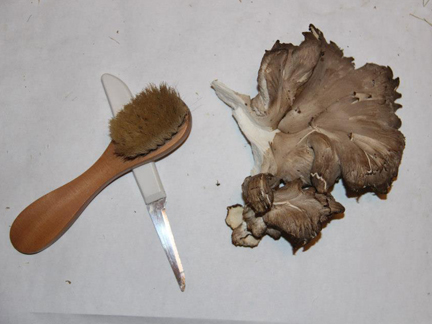
We all had suggestions for preparing them, but conversation rambled down many other roads. I had passed a four-foot tall houseplant in a garish plastic Italianate urn to Marilyn, one of my mushroom-cleaning friends. I had been slowly killing the plant, but the urn was un-killable, and I could not just throw them out. “Flourishing,” she reassured me, “The dead leaves are all gone, and it is healthy and thriving.” “Still in that baroque pot? I asked. “Er, no,” she replied. “Does anyone want it?” she asked all us around the table. There were no takers, and suggestions of gold spray paint, theatre groups, Halloween décor, and anonymously gifting to a problematic landlord were offered. The conversation veered to cremation urns, which this unfortunate plastic pot resembled, and right back to mushrooms. We were, after all, sitting with one hundred dwindling pounds of mushrooms in front of us.
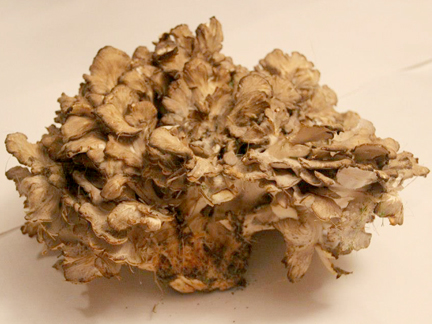
Forget urns or coffins–be buried in a corpse-consuming mushroom suit. Mushroom shrouds–I had never heard of them, but am right on board. Marilyn’s daughter told us about them, and it is a simply brilliant idea.
Jae Rhim Lee, visual artist and human-environment researcher, has founded the Infinity Death Project. The project includes a fungi-laced shroud as well as exploring cultural aspects of death denial.
From DEAF Expo, Rotterdam 2012: The Mushroom Death Suit consists of a base layer of cotton and a top layer of netting embedded with mushroom spores and mycelium, which allows the fungi to grow and spread across the body. The ‘Alternative Embalming Fluid’, liquid spore slurry that allows spores to develop and grow inside the body, accompanies the suit. Lee is training fungi to consume her own body tissue and excretions (skin, hair, nails, blood, bone, fat, tears, urine, feces and sweat) as part of her Infinity Burial Project.
Lee was asked in an interview, “How does one train a mushroom?”
Her answer: “Although the mushrooms I’m using prefer wood-based food sources, mushrooms will pretty much eat anything. The training process involves introducing different food sources to the mushrooms and then slowly depriving the mushrooms of wood-based substances. One mycologist has even trained mushrooms to eat plastics like Bakelite. “

Before learning about the mushroom suit I had requested my family donate my body to science to have eyes, heart, kidney, every usable organ used, and then let some pre-med student practice on the rest. I have held firm to this for decades. My mind was changed at the mushroom party. My organs will still be donated, but the premed student loses out. A consumer of mushrooms, being consumed by them has a sense of circular completion. I will eat maitake, chanterelles, morels, trumpets, whatever fungi is in season, with even more relish, knowing that as they sustain and give me pleasure now, I will be one day feeding them.
Mushroom party is over, but we took away an evening full of laughter, boxes full of maitake, and a plans for a new wardrobe addition–the mushroom death suit.
Note: If you gather from private property, please ask permission first. Lucky us, one of our sources is a neighbor who shudders at the thought of eating fungus. Oaks are frequently found near cemeteries, but my advice is to not gather in an area that systemic pesticides just might, maybe have been used. I would also never harvest from a tree close to a golf course. Those greens are pristine and beautifully maintained but mycelia draw from a fairly large area. It is possible that maitake do not pull nutrients beyond their host tree, but I am not taking that chance. Scientists, please tell me if you know, I have seen some lovely specimens at the edge of a golf course I just walked away from. (And lived to tell).
